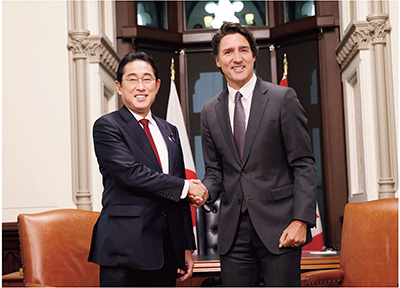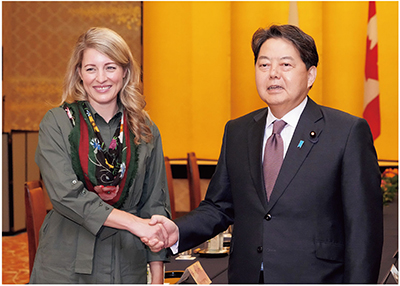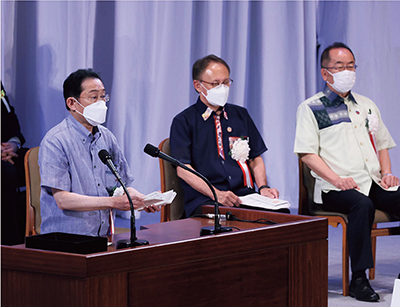Diplomatic Bluebook 2023
Chapter 2
Japan's Foreign Policy by Region
3 Canada
(1) Situation in Canada
As a result of the September 2021 general election for the House of Commons of the Parliament of Canada, all parties, including the ruling Liberal Party led by Prime Minister Justin Trudeau and the largest opposition party, the Conservative Party, won roughly the same number of seats as before the dissolution, and Prime Minister Trudeau stayed in power with a minority government (The Liberal Party had fewer than half the seats, but won the most seats of any party). In March, the ruling Liberal Party and the New Democratic Party (NDP) concluded “A Supply and Confidence Agreement” (non-coalition government) until June 2025, and succeeded in securing a stable power base despite the minority government. On the other hand, the opposition Conservative Party held a party leader election in September following the no-confidence vote on former leader Erin O'Toole. Member of Parliament Pierre Poilievre, who is the successor of former Prime Minister Stephen Harper, won a landslide victory and has shown a stance of accusing the Liberal Party administration, focusing on economic policies.
The Canadian economy was robust in 2022, maintaining the momentum of vigorous GDP growth (6.7%) from October to December 2021, with real GDP growth remaining an annual rate of around 3% through September 2022. According to the Economic Statement issued by the Canadian Department of Finance, real GDP growth in 2022 was 3.2%, the unemployment rate was near a record low of 5.4%, and 400,000 new jobs were created, more than before the COVID-19 pandemic.
On the other hand, the global oil and food price spikes and supply chain disruptions caused by the situation over Ukraine resulted in constant excess demand, and the Consumer Price Index (CPI), which was in the 1% to 4% range in 2021, rose to the 5% to 8% range at the beginning of 2022. In light of this situation, the Bank of Canada raised its policy interest rate seven times. Attention will continue to be focused on inflation trends.
On the diplomatic aspect, at the end of November, the Government of Canada announced the country's first Indo-Pacific Strategy. In addition to fields that Canada has traditionally attached importance to, including U.S.-Canada relations, the UN, the North Atlantic Treaty Organization (NATO), the G7, the G20, and the Organization of American States, this is a symbolized move that demonstrated Canada's strengthening engagement in the Indo-Pacific region. The strategy has five strategic objectives: security, including strengthening the presence of Canadian military forces in the region; economy and trade, including building a resilient supply chain and maintaining the high standards of the Comprehensive and Progressive Agreement for Trans-Pacific Partnership (CPTPP); people-to-people exchanges; climate change; and strengthening diplomacy. In response to the situation over Ukraine, Canada actively implemented sanctions against Russia and support for Ukraine, given that Canada has the world's second largest Ukrainian immigrant population and close ties to Ukraine.
On the economic front, Canada announced an agreement in January to begin preliminary talks on an investment agreement with Taiwan. In March, Canada announced an agreement to begin negotiations on a comprehensive bilateral Free Trade Agreement (FTA) with the UK.
(2) Japan-Canada Relations
From January 2022 to January 2023, four summit meetings (including two telephone calls) and four foreign ministers' meetings were held between Japan and Canada.
 Japan-Canada Summit Meeting (January 12, 2023, Ottawa, Canada; Photo: Cabinet Public Affaris Office)
Japan-Canada Summit Meeting (January 12, 2023, Ottawa, Canada; Photo: Cabinet Public Affaris Office)In June, Prime Minister Kishida, who was visiting Germany to attend the G7 Elmau Summit, held a meeting with Prime Minister Trudeau. The two leaders welcomed the close cooperation between the two countries, including in responding to Russia's aggression against Ukraine, and agreed to promote concrete, strong cooperation toward realizing FOIP, and to closely cooperate on the CPTPP. They also agreed to closely cooperate toward the success of the G7 Hiroshima Summit in 2023.
In October, Foreign Minister Hayashi and Foreign Minister Mélanie Joly, who was visiting Japan as a guest of the Ministry of Foreign Affairs, announced the Japan-Canada Action Plan for contributing to a free and open Indo-Pacific region. The Action Plan compiles specific initiatives in the Six Shared Priorities2 of Japan and Canada, and includes the start of formal negotiations for a General Security of Information Agreement (GSOIA) and energy cooperation. Canada's abovementioned Indo-Pacific Strategy also mentions implementation of cooperation with Japan in the Six Shared Priorities, and calls for further Japan-Canada cooperation.
 Japan-Canada Foreign Ministers' Meeting and Working Dinner (October 11, Tokyo)
Japan-Canada Foreign Ministers' Meeting and Working Dinner (October 11, Tokyo)In January 2023, Prime Minister Kishida held a meeting with Prime Minister Trudeau during his visit to Ottawa, the first visit in four years by a Prime Minister of Japan. Prime Minister Kishida spoke about Japan's new National Security Strategy and cooperation toward the G7 Hiroshima Summit, and received full support. The two leaders also confirmed cooperation toward realizing FOIP through steady implementation of the Japan-Canada Action Plan. Furthermore, they concurred on cooperation for regional affairs, economic fields such as energy and food, the CPTPP, and economic security.
Although trade between Japan and Canada declined in 2020 because of the effects of the COVID-19 pandemic, there has been a steady recovery throughout 2021 and in 2022 as well. Trade and investment relations have further deepened, with the two countries marking four years since the entry into force of the CPTPP, the first economic partnership agreement between Canada and Japan. In December, the 32nd Meeting of the Japan-Canada Joint Economic Committee (JEC) was held in an online format. In addition to exchanges of views on recent international economic developments, such as the CPTPP and the WTO, and the realization of FOIP, among other areas of Japan-Canada cooperation, there were discussions on six priority areas of cooperation3, including energy and infrastructure.
- 2 Six Priority Areas of Cooperation: (1) The Rule of Law; (2) Peacekeeping Operations, Peacebuilding, and Humanitarian Assistance and Disaster Relief; (3) Health Security and Responding to COVID-19; (4) Energy Security; (5) Free Trade Promotion and Trade Agreement Implementation; (6) Environment and Climate Change
- 3 Priority areas of cooperation: (1) Energy; (2) Infrastructure; (3) Science and technology cooperation and innovation; (4) Tourism and youth exchange; (5) Improving the business environment and promoting investment; (6) Agriculture, etc.
“Citizens, Okinawa has been reverted to Japan today.” This was the declaration of the reversion made by Prime Minister SATO Eisaku on stage in front of the crowd gathered at the Nippon Budokan at the commemoration ceremony of the reversion of Okinawa to Japan on May 15, 1972. Okinawa experienced fierce ground battles in World War II. It remained under U.S. administration for 27 years following the end of the war, even after the Allied occupation of Japan ended. Overcoming this history of hardship, the reversion of Okinawa to Japan was achieved as the long-cherished wish of the people of Okinawa and all of Japan based on the dedicated efforts of the people of Okinawa and the friendship and trust between Japan and the U.S.
 Prime Minister Kishida delivering a commemorative address at the ceremony commemorating the 50th anniversary of the reversion of Okinawa to Japan (May 15, Okinawa; Photo: Cabinet Public Affairs Office)
Prime Minister Kishida delivering a commemorative address at the ceremony commemorating the 50th anniversary of the reversion of Okinawa to Japan (May 15, Okinawa; Photo: Cabinet Public Affairs Office)The year 2022, which marked the 50th anniversary of the reversion of Okinawa to Japan, was a year in which many people reflected anew on the way Okinawa has come through, and present situation and future possibilities of Okinawa, as the Government of Japan and various organizations conducted commemorative projects and the Diet adopted a resolution on the 50th anniversary of Okinawa's reversion to Japan.
On May 15, exactly 50 years after the reversion, the ceremony commemorating the 50th anniversary of the reversion of Okinawa to Japan was held. Although the ceremony was held at two venues in Okinawa and Tokyo simultaneously like 50 years ago, it was also held in a manner that reflected the Reiwa era, in part due to the impact of COVID-19, with the two venues being connected in a virtual format and the online attendance by Their Majesties the Emperor and Empress. Furthermore, at the ceremony, President Biden of the U.S. gave a message expressing admiration for the current strong Japan-U.S. relationship built on the foundation of the reversion of Okinawa, stating, “the relationship between the United States and Japan has transformed from one of battlefield foes to allies united in common purpose, now the closest of friends. Reversion represented an end to one chapter of our relationship and the beginning of another.”
In his congratulatory address at the ceremony commemorating the 50th anniversary of the reversion of Okinawa to Japan, Prime Minister Kishida stated, “I would like to again reflect on the history of Okinawa and express my deep respect for the dedicated efforts of the people of Okinawa.” Needless to say, Okinawa's development to date has been the result of the tireless efforts of the people of Okinawa. Additionally, Okinawa's geographical characteristics due to its location in the center of East Asia, its rich natural environment, and its mild climate have made it an area where a unique cosmopolitan culture has blossomed and developed to date. The culture and traditions that have been nurtured throughout its history since the era when Okinawa was known as the Ryukyu Kingdom have captivated tourists from around the world, and Okinawa has great potential to continue to develop as a center for international exchange.
MOFA is taking various initiatives to contribute to the internationalization of Okinawa. With regard to the overseas expansion of Okinawa's specialty products, MOFA is working with the Cabinet Office, Cabinet Secretariat, National Tax Agency, Ministry of Agriculture, Forestry and Fisheries, Japan External Trade Organization (JETRO), and others in the Ryukyu Awamori Overseas Export Project to make the attractiveness of Awamori known to the world through diplomatic missions overseas. MOFA has also sent a number of high school and university students in Okinawa to the U.S. through the “Think of Okinawa's Future in the U.S.” (TOFU) program. This program aims to develop future leaders of Okinawa, who will also play an active role in the international society, hoping that this will lead to further development of Japan-U.S. relations. Furthermore, in 2022, the Project to Promote Exchanges and Enhance Mutual Understanding between Japan and the U.S. (Youth Exchange Program) was conducted for the first time in Okinawa Prefecture. Held in communities that host facilities and areas of U.S. Forces Japan, this program provides opportunities for local Japanese junior and high school students and American children of U.S. Forces personnel, to deepen mutual understanding through cultural and educational exchanges (see the Column on page 204). The U.S. is also working to strengthen its ties with Okinawa through efforts such as launching an English language scholarship program for high school students in Okinawa, as announced by U.S. Ambassador to Japan Rahm Emanuel at the ceremony commemorating the 50th anniversary of the reversion of Okinawa to Japan. Such human resources development through the promotion of people-to-people exchanges between Okinawa and the U.S. is expected to further solidify the ties between Japan, including Okinawa, and the U.S.
